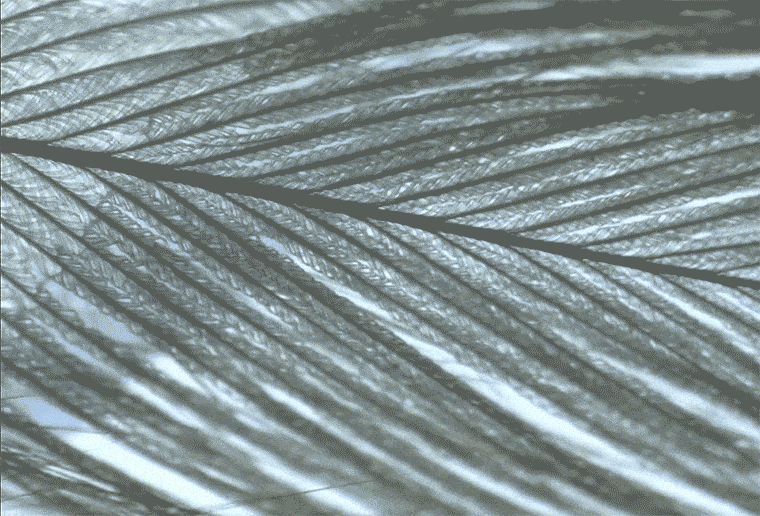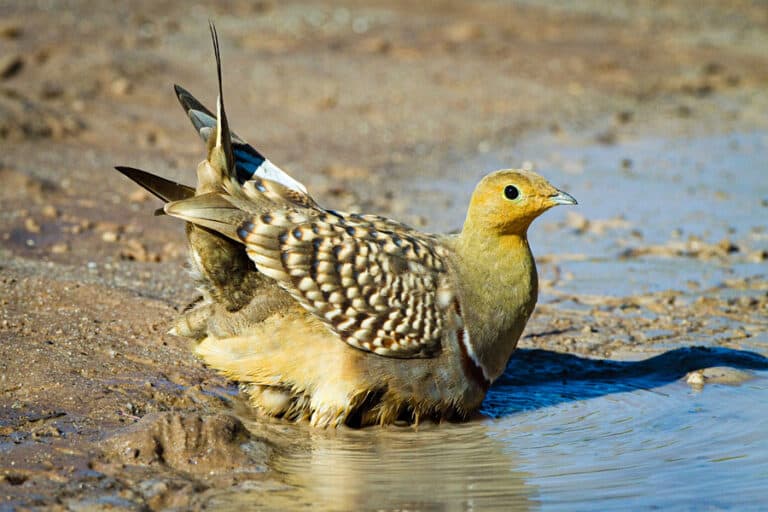Photo: The belly feathers of the Namaqua Sandgrouse can absorb and retain water so efficiently that the male birds can fly more than 20 kilometers from a distant watering hole back to the nest and still retain enough water in their feathers for the chicks to drink. Image: iStock
Many birds’ feathers are remarkably efficient at shedding water — so much so that “like water off a duck’s back” is a common expression. Much more unusual are the belly feathers of the sandgrouse, especially Namaqua sandgrouse, which absorb and retain water so efficiently the male birds can fly more than 20 kilometers from a distant watering hole back to the nest and still retain enough water in their feathers for the chicks to drink and sustain themselves in the searing deserts of Namibia, Botswana, and South Africa.
How do those feathers work? While scientists had inferred a rough picture, it took the latest tools of microscopy, and patient work with a collection of sandgrouse feathers, to unlock the unique structural details that enable the feathers to hold water. The findings appear today in the Journal of the Royal Society Interface , in a paper by Lorna Gibson, the Matoula S. Salapatas Professor of Materials Science and Engineering and a professor of mechanical engineering at MIT, and Professor Jochen Mueller of Johns Hopkins University.
The unique water-carrying ability of sandgrouse feathers was first reported back in 1896, Gibson says, by E.G.B. Meade-Waldo, who was breeding the birds in captivity.
“He saw them behaving like this, and nobody believed him! I mean, it just sounded so outlandish,” Gibson says.
In 1967, Tom Cade and Gordon MacLean reported detailed observations of the birds at watering holes, in a study that proved the unique behavior was indeed real. The scientists found that male sandgrouse feathers could hold about 25 milliliters of water, or about a tenth of a cup, after the bird had spent about five minutes dipping in the water and fluffing its feathers.

Credit: Specimen #142928, Museum of Comparative Zoology, Harvard University © President and Fellows of Harvard College.
About half of that amount can evaporate during the male bird’s half-hour-long flight back to the nest, where the chicks, which cannot fly for about their first month, drink the remainder straight from the feathers.
Cade and MacLean “had part of the story,” Gibson says, but the tools didn’t exist at the time to carry out the detailed imaging of the feather structures that the new study was able to do.
Gibson and Mueller carried out their study using scanning electron microscopy, micro-computed tomography, and video imaging. They borrowed Namaqua sandgrouse belly feathers from Harvard University’s Museum of Comparative Zoology, which has a collection of specimens of about 80 percent of the world’s birds.
Bird feathers in general have a central shaft, from which smaller barbs extend, and then smaller barbules extend out from those. Sandgrouse feathers are structured differently, however. In the inner zone of the feather, the barbules have a […]
Full article: news.mit.edu


